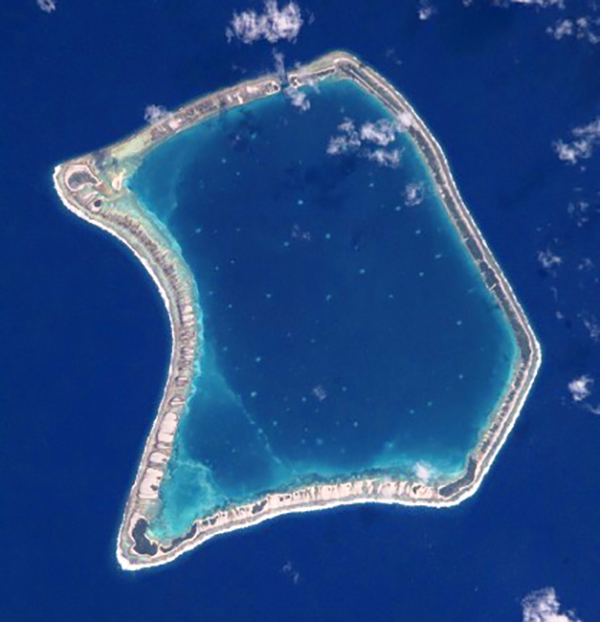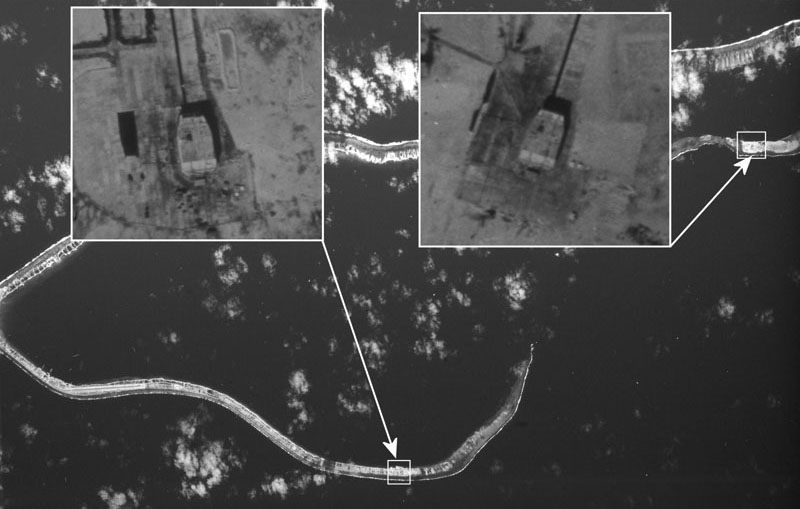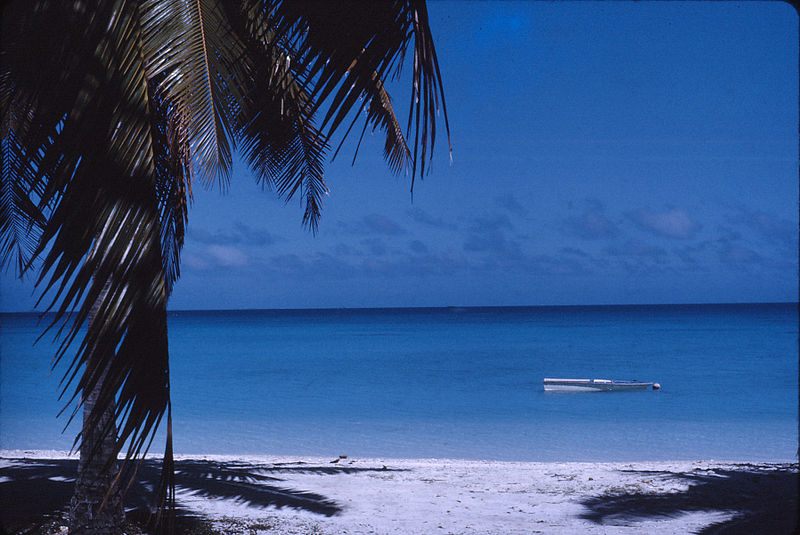How the Miracle Mollusks of Fangataufa Came Back After a Nuclear Blast
 An aerial view of Fangatuafa atoll, the site of France’s 1968 nuclear bomb test. (Photo: Public Domain/WikiCommons)
An aerial view of Fangatuafa atoll, the site of France’s 1968 nuclear bomb test. (Photo: Public Domain/WikiCommons)
In the 1960s and 70s, France conducted 193 nuclear tests in French Polynesia, transforming this stretch of paradise into a field of blooming mushroom clouds.
The largest of these blasts occurred in 1968, when the French government detonated a hydrogen bomb on the Fangataufa atoll, a small, enclosed coral reef that forms a lagoon, almost like a bathtub, in the middle of the ocean. Sacrificed at the altar of global security, at the peak of Cold War paranoia, the reef was singed to a crisp.
“This was a much bigger blast than the others and it was done at low tide,” says Pierre Legendre, a statistical ecologist at the University of Montreal who has been collecting and analyzing data on Fangataufa since 1997. This meant that most of the vegetation was incinerated and “virtually every mollusk was fried.”
Fangataufa and other nearby atolls were selected for the testing because they were so remote, but the radioactive fallout traveled further than expected. According to recently declassified documents, the tests exposed Tahiti to 500 times the maximum level of radiation, and also affected Bora Bora, an island that’s popular with honeymooners. Forty-five years later, Polynesia suffers from a high incidence of thyroid cancer and leukemia, and thousands of veterans and civilians are still battling for compensation over health issues.
 A ‘Chambered Nautilus’ mollusc. (Photo: Bill Abbott/flickr)
A ‘Chambered Nautilus’ mollusc. (Photo: Bill Abbott/flickr)
In light of this toxic seepage, it seems that an epicenter like Fangataufa should have been obliterated, or least remain a dead zone. And yet the opposite is true. After surveying the atoll for more than 30 years, scientist Bernard Salvat, who later hired Legendre to analyze his findings, say that its mosses and plants have returned. Even more remarkable is that the mollusks who were fried on its rocky perimeter back in 1968—mollusks that Salvat has been studying since before the tests occurred—have also made something of a comeback.
The resurgence of the mollusks is the subject of Salvat and Legendre’s newly published study. The first of its kind to ever appear in public scientific literature, the paper analyzes 30 years of data that Savat collected from the hydrogen-blasted rocks of Fangataufa, using Legendre’s statistical methods. And it seeks to answer one of the fundamental questions of modern life: what happens after nuclear annihilation? How does nature respond? If it comes back, will it be different, and how?
The answer, say Salvat and Legendre, doesn’t just lie with fate, or the strength of a species, or natural design. It boils down to something more random. If the resurgence of the mollusks was a miracle, it was a miracle of chance.
The story of the mollusks begins far from the atolls of Polynesia, in a school of practical studies in Paris, where Savat was teaching oceanography back in 1966. The young researcher had already made a name for himself as one of the few researchers in the nation to have studied at New Caledonia, home of some of the world’s largest enclosed reefs. Savat had also become friendly with the director of the Museum of Natural History, who worked just down the street, and he was working with the Direction des Centres d’Experimentation Nucleaires (DIRCEN), established to administer nuclear testing.
So when one of the DIRCEN committees began casting about for a researcher to do surveys on one enclosed reef in French Polynesia that would soon be used for nuclear testing, Savat was the obvious choice. Along with two other researchers (one who studied fish, another who studied coral), Savat was tapped to survey Fangataufa’s mollusks, before and after the blasts.
 A satellite reconnaissance image of Mururoa atoll, the sister test site to Fangatuafa, in 1967. (Photo: Public Domain/WikiCommons)
A satellite reconnaissance image of Mururoa atoll, the sister test site to Fangatuafa, in 1967. (Photo: Public Domain/WikiCommons)
Savat immediately saw the offer for what it was: a rare opportunity to study primary succession—that is, what happens ecologically and biologically in the wake of total destruction. It’s a subject most scientists don’t get to study, because it’s hard to create total destruction under experimental conditions.
“I can’t go to the funding agency here in Canada and say, ‘I’m going to destroy the vegetation for the animals on an island, especially with an atomic bomb, in order to study succession,’” Legendre says. “They would reject my grant, and they would be right, because it would be immoral. So Bernard knew he had the chance to study what would be impossible in normal scientific contexts. This makes our data unique in the world.”
Savat’s expeditions to Fangataufa began in 1967. He returned again in 1968 and 1970, and then again in 1972, after the testing on Fangataufa was complete. He fixed rope ladders to the reefs so he could anchor himself during dives. He explored the atoll and its neighbors in a nimble inflatable boat. At some point, the other two researchers abandoned their projects, after finding that much of the fish and coral had been protected from the blast by the water, making it difficult to study their recovery in any concrete way.
The mollusks, however, made excellent subjects. Unlike fish, they are slow moving, easy to identify, and can live in the shallowest waters, making them easy to study. They also have relatively long lifespans—a mollusk lives up to ten years—so the generational turnover in any given spot is relatively low. All of these characteristics made it easier to observe what happened to them after the blasts.
 A ‘Cypraea textile’ mollusk. (Photo: Harry Rose/flickr)
A ‘Cypraea textile’ mollusk. (Photo: Harry Rose/flickr)
By 1997, Savat had conducted eight field surveys on the reef, at which point he hired Legendre to analyze his data.
The mollusks’ resurgence, their research shows, happened surprisingly quickly. As early as 1972, mollusks had begun to cluster along the rocks, recolonizing the tide pools and upper reaches of the reef. To the untrained eye, it looked as though the same populations of mollusks were coming back. But they were different than before.
Mollusks reproduce by sending their larvae out into the ocean, where they ride the waves and currents for up to thousands of miles, like a scene from “Finding Nemo.” Most of these larvae get eaten by fish and other creatures, but the lucky ones will eventually run into an island, or a reef. As soon as they make contact, they stick out their toes and attach.
This means that the new mollusks of Fangataufa didn’t rise up from the nuclear ashes, like mini shelled phoenixes. Instead, they came by way of waves, drifting from other islands and reefs that may have been thousands of miles away. Unlike the animals of Chernobyl, which were affected by the radiation for generations, the mollusk larvae were genetically fresh.
Many were also different species than the ones before the tests. And this is where the study gets controversial. For years, most ecologists believed that species were controlled exclusively by environmental conditions—in other words, a species lives where the environmental conditions suit them best. Ecologists call this species sorting, and it was the dominant theoretical paradigm when Legendre began his career.
 The lagoon at Mururoa atoll in 1972. (Photo: Georges Martin/WikiCommons CC BY 3.0)
The lagoon at Mururoa atoll in 1972. (Photo: Georges Martin/WikiCommons CC BY 3.0)
Then in 2001, an ecologist named Stephen Hubbell, whose specialty was tropical forests, hypothesized that where a species settles isn’t determined only by environmental conditions—in fact, Hubbell said it was much more random than that. Citing ideas like “random drift,” and suggesting that every species takes a “random walk” to determine where it lives, Hubbell called this hypothesis the unified neutral theory of biodiversity.
Legendre helped explain. “Imagine how the cloud transmits data to your computer. It’s about the same with the neutral theory. There are organisms in the cloud and some of them settle in the area that you are studying. Some may be happy there, some may be marginally happy there, and others don’t settle there at all. So there is a big random component to the process.”
Hubbell’s theory has been heavily debated, with ecologists arguing that not every species has an equal chance of colonizing. And even Hubbell was skeptical of Savat and Legendre’s results: “On the face of it, certainly [the results] are consistent with it, but it doesn’t in my opinion prove it. It isn’t a slam dunk,” he told Science Magazine.
Still, the mollusks of Fangataufa offer compelling evidence that their arrival was a matter of chance. After sampling three different portions of the reef, Savat and Legendre found that only three out of 36 species of mollusks were the same as the ones that had been there before the blasts. Meanwhile, on the other two portions of the reef, the composition of species had changed completely, and were also completely different from each other.
“Over the course of many years of surveys, we found the mix of species slowly changed,” Legendre says. “The mollusks that were there at the beginning, lived about 10 years, and were then replaced by new larvae coming in from the ocean.” It’s a process, then, that will continue to occur, as long as Fangataufa remains and there are mollusks around to run into it.
Legendre’s observation seems like “random drift” in action. And the fact that some of the mollusks were eking out a living in sub-ideal conditions seems to support that idea that not every species gets to live in a place that suits them best. Some of the plant-eating mollusks, for instance, had colonized a higher portion of the reef that was especially harsh and dry. Here, they spent three weeks of every month surviving off what little bit of water they had captured in their shells, while they waited for the next full moon to usher in the tide.
If the story behind these mollusks is starting to sound more existential than miraculous, Legendre might agree: “They settled in that way by chance when they encountered the hard substrate,” he says of the mollusks high on the reef. “It’s not ideal, but of course it is better for them than just floating in the ocean, where they would be eaten by the next fish that comes along.”







Follow us on Twitter to get the latest on the world's hidden wonders.
Like us on Facebook to get the latest on the world's hidden wonders.
Follow us on Twitter Like us on Facebook